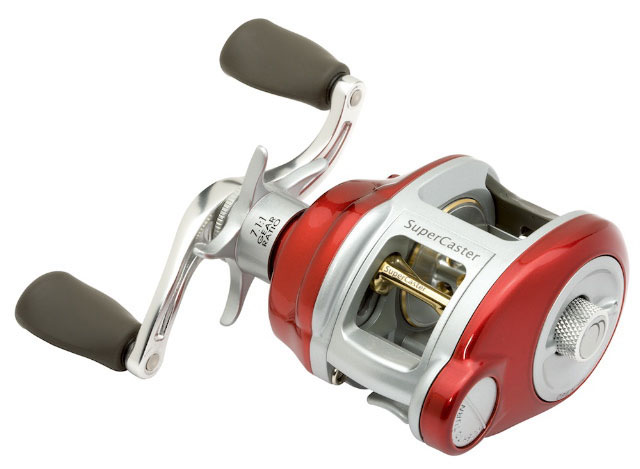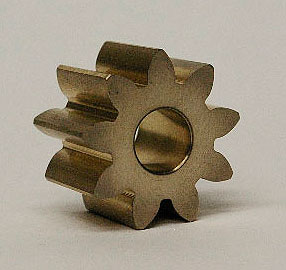Gears are the unit of choice for transmitting rotational force. New applications and new materials are affecting gear making and gear finishing. Here’s a look at a few of those applications.
Sometimes a slight modification is all that is needed to eliminate several process steps, increase range of motion, create a new product, or improve efficiency. When customers of Forest City Gear (FCG), Roscoe, Ill., sought design changes to improve their products, the use of internal helical gears proved to be the answer in many cases. These gears may not be the easiest type of gear to make, but FCG uses special helical gear cutters to meet the customer requirements in the following applications.

Forest City Gear made the gears for the key articulation sectors used in the myoelectric Utah Arm, from Motion Control, Inc. The gearing arrangement replaced a multi-step, two-piece process, saving time and cost.

In newer prosthetic arms, gears play an important role in enabling a fluid, functional motion that more realistically substitutes for a missing limb. Motion Control, Inc., Salt Lake City, one of the Fillauer Companies, is a leader in myoelectric prosthetic devices and developed the Utah Arm, an advanced prosthetic elbow/hand built for above-elbow amputees. The company works in conjunction with the University of Utah’s Center for Engineering Design and the two developers are on the third iteration of the Utah Arm prosthetic.
Many veterans of the Iraqi war have been fitted with the Utah Arm 3 at Walter Reed Medical Center and Brooke Army Medical Center. Motion Control also released the myoelectric hand and Electric Terminal Device (ETD) to complete its line. Such features as a strong motor, strong fingers, battery save mode, wider grip, and quick disconnect wrist enable the MC Hand to move quickly and wear well.
Microprocessor technology was incorporated into the Utah Arm 3 in 2004. Two microcontrollers are programmed for the elbow and hand, allowing separate inputs and therefore simultaneous control of both. The wearer can operate the elbow and hand at the same time for more natural function than was possible before. In addition, the U3 uses a computer interface, which simplifies fine-tuning of the elbow and hand controls.
Arc sector gears transmit the motion from the controllers. The arm does not need 360 degrees of rotation, so these gears were deemed sufficient to deliver the needed motion. The mating pinion has a small number of teeth, which yields a high ratio to reduce the number of gear stages, saving weight, space and money.

A special helical shaper cutter created different cuts to the gear and shaped the teeth in the tight space next to the sector gear arm. The special cutter allowed the part to be made in one piece,eliminating the need for welding.
For many years, the team at Motion Control made the sector gears in a multi-step process that included: machining two separate parts, welding the parts together, grinding down the weld, hardening the part, and then having a vendor cut the gear teeth and handle final post machining. The problems with this process were:
— Each step required time and money to move the parts from one vendor to the next and usually took six months from initial order to finished part.
— The two gear parts were welded together. Sometimes welding distorted the gear parts, making later assembly alignment difficult.
— Inconsistent welds resulted in a lot of waste.
— Post machining the holes often broke drills and taps near the weld-hardened material. The company expected to lose 10-15% of the product before the process finished.
— And there was a question of smoothness. The gears were not performing as hoped.
Experienced gear cutter, Forest City Gear, cut the gear teeth and handled final post machining for Motion Control. The engineers at FCG saw that a small modification to the gear contact ratio by extending tooth length would increase gear strength, reduce noise, and help smooth arm motion. The challenge was cutting the teeth with the sector gear arm in the way. Traditonal gear cutting equipment could not cut the teeth right up next to the sector gear arm, thus requiring the welding step.
The challenge was met with a special helical shaper cutter that not only created different cuts to the gear, it also shaped the teeth in the tight space next to the sector gear arm. The special cutter allowed the part to be made in one piece, eliminating the need for welding. The cutter also helped eliminate the multiple back and forth shipping.
A new cast
Gear contact ratio also played a key role in a revolutionary redesign of a fishing reel. Experienced fishermen feel every motion in bait casting reels. The goal of U.S. Reel’s new reel was to develop constant smooth motion rather than the usual stop and start typical of reels. The development team wanted to eliminate the “stickiness” common to reels to make the motion so smooth that fishermen would not notice it.

A compact internal gear mechanism enabled U.S. Reel to develop the SuperCaster 1000, a fishing reel with no-eyelet, and a virtually friction-free high-speed retrieve operation.

The new SuperCaster 1000 reel from the St. Louis company has a same-direction, no eyelet, virtually friction-free, high-speed retrieve rate in large part because of the internal gear mechanism built by FCG.
Engineers at U.S. Reel produced their initial design to the CAD stage in Catia, SolidWorks and Pro-E formats. Then, they worked with an outside consultant well known in fishing circles who suggested placing the gearing inside the reel rather than outside. Conventional bait casting reels use two external gears for retrieval of the line. Placing the gears inside makes the reel smaller and more compact and reverses the direction of the spool during line retrieval, which delivers a smoother line return without the friction that causes stopping and starting motion.
The new gearing mechanism, similar to those commonly found in spincasting reels, achieved the reverse rotation of the SuperCaster 1000 spools. Most 7-to-1 retrieve reels have a large casing on the main-gear side of the reel that often protrudes down beyond the reel foot. In the new design, an internal helical gear runs against a pinion and changes the traditional direction of rotation for bringing the line onto the reel, while the line retrieve mechanism reduces drag allowing greater distance in casting.
The retrieve function is enhanced by an Angled Bar Levelwind (ABLe™) that creates a seesaw effect to guide the line. Noted Fred Kemp, president of U.S. Reel, “Spool control is easier with the spool turning into the thumb rather than moving away from it.” The spool is forged aluminum with stainless steel ball bearings for optimally smooth motion.
The new main gear is made of 7075 aluminum with internal helix, 0.45 module. With this gear design, fishermen do not need to muscle line retraction.
Noted Fred Young, CEO, FCG, “This was one of the toughest challenges for us because any irregularity in gear operation is easily detectable in the hands of an experienced fisherman. We knew we were breaking new ground with this design.”

A hob gear with added flats improved the efficiency of this oil pump and starter pulley gear unit made for Frank Weiss Racing.

In the fast lane
At Frank Weiss Racing Components, Inc., (FWRC) located on Gasoline Alley in Indianapolis, the engineers needed hob gearing for an oil-pump that would deliver a high-pressure pump angle. FWRC specializes in the machining, fabricating and assembly of various oil systems, exhaust systems, and starters for teams competing at the top auto racing venues in America.
Usually, high-pressure angles are easy with a large number of teeth. This oil pump design, however, was not suitable to an increase in the number of teeth. It had a gear that featured fewer teeth with a relatively high-pressure angle. Such a design can be a recipe for trouble on oil pump gears, causing them to be rough in rolling action, plus it can contribute to loss of pumping volume.
FCG consultants suggested cutting generating flats on the flank of the teeth. Increasing the number of flats would improve accuracy and increase the efficiency of pumping because less oil would be lost. FCG processes various alloy steel, bronze and titanium gears with performance ratings up to 850 hp for FWRC.
Forest City Gear Co., Inc.
www.forestcitygear.com
Filed Under: MECHANICAL POWER TRANSMISSION, Gears • gearheads • speed reducers, Motion control • motor controls





Tell Us What You Think!